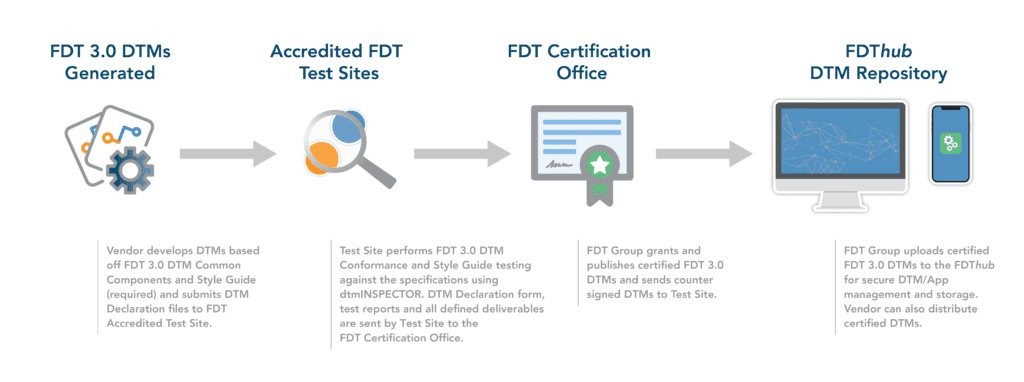
DTM certification has become an essential marketplace factor progressing the cohesiveness of the FDT standard with the new Industry 4.0 world. Executed today as the de facto integration standard for any network, device, or hosting environment, FDT Group began offering a DTM certification regime in 2005 driven entirely by industry demand allowing the user community to freely mix and match best-in-breed devices and hosting environments, offering best interoperability assurance for any process, hybrid, or discrete application.
Through the early certification process, vendors could elect to submit their DTMs to an independent, FDT Accredited Testing Site to determine conformance to the FDT technical specifications. A few years later at the request from the industry, FDT Group released a User Interface (UI) style guide to the marketplace that established a common navigation and information scheme for DTMs regardless of the vendor. As the marketplace demand for style guide compliance grew, FDT Group included optional style guide compliance testing within the certification process. Today, certified FDT 1.x or FDT 2.x DTMs that meet both specification and UI style guide compliance offer the assurance of utmost interoperability and improves the experience of automation end-users for both FRAME/Desktop and Client/Server environments.
Looking forward, we find our industry changing rapidly in support of new innovative and digital-based business models to simplify operations and to increase productivity through IIoT and I4.0 trends. With the release of the FDT 3.0 IIoT Server-based architecture, the standard now finds itself as a core component for any new era automation application. The secure, data-centric, platform independent, browser-based solution now extends a rich information source for IT and OT personnel. Naturally, the certification requirements and process also evolved to support this larger capability and deployment flexibility to ensure greater consistency and interoperability success for next generation applications. This included collaborating with key industry associations such as NAMUR to sculpt the new FDT 3.0 certification requirements.
With the hard work behind us, thanks to the tireless work from our Test and Certification Working Group and collaborative efforts with NAMUR, we are proud to announce that the FDT 3.0 certification process has been fully defined and FDT 3.0 DTM testing and certification is now open! Vendors interested in FDT 3.0 DTM Development, Testing and Certification are encouraged to review details on the FDT development website.

In short, the new certification requirements for FDT 3.0 mandate that all DTMs be certified prior to reaching the market. This includes both specification and WebUI style guide compliance ensuring cross platform functionally with a consistent yet responsive UI supporting any mobile device or browser – a key beneficial feature with FDT 3.0. Additionally, all DTMs must be developed using the FDT 3.0 DTM Common Component tool kit. This tool kit includes thousands of lines of digitally signed, pretested code that allows the DTM developer to focus on customized, value-add features for their DTM and less on the nuances of FDT standard compliance thereby allowing the vendor to achieve a quicker time-to-market. This tool kit approach tied with the new automated certification process allows DTMs to pass through the certification regime quickly and more reliably.
I want to highlight that our new certification process includes procedures that automate the secure availability of FDT DTM’s from the new FDThub cloud based DTM repository! All FDT 3.0 Server and Desktop environments are FDThub capable, enabling automatic device discovery and downloads for matching DTMs, while also enabling notifications when necessary DTM software updates are available. Offline integration where an air-gapped environment is needed is also available. Authenticated applications with access to the cloud based electronic repository of fully certified DTMs is the result of many consultations with industry leaders. Rather than burdening the vendor community with the nuances of publishing their DTM in the FDThub, we have integrated the uploading and publishing process with the certification process.
As the first FDT 3.0 DTMs come through our new certification process over the next few weeks, I think you will be pleased with the results. Our vendor and end user communities have generously contributed ideas, hours, and people to bring us to this point; so, on behalf of the Board of Directors of the FDT Group, I thank you for your resolve, talents and results.
Lee Lane, Chairman of the FDT Board of Directors